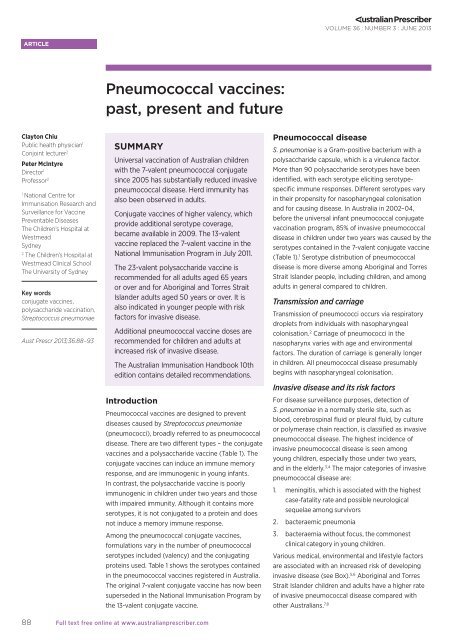download the full PDF issue - Australian Prescriber
download the full PDF issue - Australian Prescriber
download the full PDF issue - Australian Prescriber
You also want an ePaper? Increase the reach of your titles
YUMPU automatically turns print PDFs into web optimized ePapers that Google loves.
VOLUME 36 : NUMBER 3 : JUNE 2013<br />
ARTICLE<br />
Pneumococcal vaccines:<br />
past, present and future<br />
Clayton Chiu<br />
Public health physician 1<br />
Conjoint lecturer 2<br />
Peter McIntyre<br />
Director 1<br />
Professor 2<br />
1<br />
National Centre for<br />
Immunisation Research and<br />
Surveillance for Vaccine<br />
Preventable Diseases<br />
The Children’s Hospital at<br />
Westmead<br />
Sydney<br />
2<br />
The Children’s Hospital at<br />
Westmead Clinical School<br />
The University of Sydney<br />
Key words<br />
conjugate vaccines,<br />
polysaccharide vaccination,<br />
Streptococcus pneumoniae<br />
Aust Prescr 2013;36:88–93<br />
SUMMARY<br />
Universal vaccination of <strong>Australian</strong> children<br />
with <strong>the</strong> 7-valent pneumococcal conjugate<br />
since 2005 has substantially reduced invasive<br />
pneumococcal disease. Herd immunity has<br />
also been observed in adults.<br />
Conjugate vaccines of higher valency, which<br />
provide additional serotype coverage,<br />
became available in 2009. The 13-valent<br />
vaccine replaced <strong>the</strong> 7-valent vaccine in <strong>the</strong><br />
National Immunisation Program in July 2011.<br />
The 23-valent polysaccharide vaccine is<br />
recommended for all adults aged 65 years<br />
or over and for Aboriginal and Torres Strait<br />
Islander adults aged 50 years or over. It is<br />
also indicated in younger people with risk<br />
factors for invasive disease.<br />
Additional pneumococcal vaccine doses are<br />
recommended for children and adults at<br />
increased risk of invasive disease.<br />
The <strong>Australian</strong> Immunisation Handbook 10th<br />
edition contains detailed recommendations.<br />
Introduction<br />
Pneumococcal vaccines are designed to prevent<br />
diseases caused by Streptococcus pneumoniae<br />
(pneumococci), broadly referred to as pneumococcal<br />
disease. There are two different types – <strong>the</strong> conjugate<br />
vaccines and a polysaccharide vaccine (Table 1). The<br />
conjugate vaccines can induce an immune memory<br />
response, and are immunogenic in young infants.<br />
In contrast, <strong>the</strong> polysaccharide vaccine is poorly<br />
immunogenic in children under two years and those<br />
with impaired immunity. Although it contains more<br />
serotypes, it is not conjugated to a protein and does<br />
not induce a memory immune response.<br />
Among <strong>the</strong> pneumococcal conjugate vaccines,<br />
formulations vary in <strong>the</strong> number of pneumococcal<br />
serotypes included (valency) and <strong>the</strong> conjugating<br />
proteins used. Table 1 shows <strong>the</strong> serotypes contained<br />
in <strong>the</strong> pneumococcal vaccines registered in Australia.<br />
The original 7-valent conjugate vaccine has now been<br />
superseded in <strong>the</strong> National Immunisation Program by<br />
<strong>the</strong> 13-valent conjugate vaccine.<br />
Pneumococcal disease<br />
S. pneumoniae is a Gram-positive bacterium with a<br />
polysaccharide capsule, which is a virulence factor.<br />
More than 90 polysaccharide serotypes have been<br />
identified, with each serotype eliciting serotypespecific<br />
immune responses. Different serotypes vary<br />
in <strong>the</strong>ir propensity for nasopharyngeal colonisation<br />
and for causing disease. In Australia in 2002–04,<br />
before <strong>the</strong> universal infant pneumococcal conjugate<br />
vaccination program, 85% of invasive pneumococcal<br />
disease in children under two years was caused by <strong>the</strong><br />
serotypes contained in <strong>the</strong> 7-valent conjugate vaccine<br />
(Table 1). 1 Serotype distribution of pneumococcal<br />
disease is more diverse among Aboriginal and Torres<br />
Strait Islander people, including children, and among<br />
adults in general compared to children.<br />
Transmission and carriage<br />
Transmission of pneumococci occurs via respiratory<br />
droplets from individuals with nasopharyngeal<br />
colonisation. 2 Carriage of pneumococci in <strong>the</strong><br />
nasopharynx varies with age and environmental<br />
factors. The duration of carriage is generally longer<br />
in children. All pneumococcal disease presumably<br />
begins with nasopharyngeal colonisation.<br />
Invasive disease and its risk factors<br />
For disease surveillance purposes, detection of<br />
S. pneumoniae in a normally sterile site, such as<br />
blood, cerebrospinal fluid or pleural fluid, by culture<br />
or polymerase chain reaction, is classified as invasive<br />
pneumococcal disease. The highest incidence of<br />
invasive pneumococcal disease is seen among<br />
young children, especially those under two years,<br />
and in <strong>the</strong> elderly. 3,4 The major categories of invasive<br />
pneumococcal disease are:<br />
1. meningitis, which is associated with <strong>the</strong> highest<br />
case-fatality rate and possible neurological<br />
sequelae among survivors<br />
2. bacteraemic pneumonia<br />
3. bacteraemia without focus, <strong>the</strong> commonest<br />
clinical category in young children.<br />
Various medical, environmental and lifestyle factors<br />
are associated with an increased risk of developing<br />
invasive disease (see Box). 5,6 Aboriginal and Torres<br />
Strait Islander children and adults have a higher rate<br />
of invasive pneumococcal disease compared with<br />
o<strong>the</strong>r <strong>Australian</strong>s. 7,8<br />
88<br />
Full text free online at www.australianprescriber.com
















